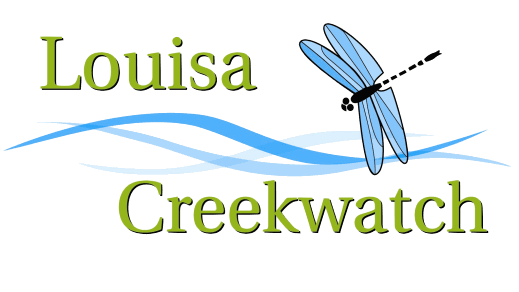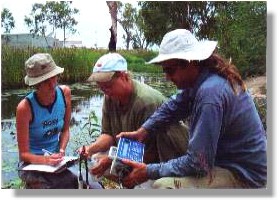
Louisa Creekwatch volunteers
monitoring water quality
|
WHAT
IS LOUISA CREEKWATCH?
Are you interested
in becoming involved in catchment management issues concerning Louisa
Creek?
If so, get
involved in Louisa Creekwatch a volunteer program that spends one day
a week monitoring water quality and raising awareness of water quality
issues in Louisa Creek
|
|
Background on Louisa Creek?
 Louisa
Creek is one of the most important streams in Townsville's urban environment.
The creek retains some important remnants of native vegetation and is
an important native fish habitat due to it's connectivity to the Townsville
Town Common. In the current Townsville setting, the creek is managed for
both its environmental value but also for its function in flood mitigation. Louisa
Creek is one of the most important streams in Townsville's urban environment.
The creek retains some important remnants of native vegetation and is
an important native fish habitat due to it's connectivity to the Townsville
Town Common. In the current Townsville setting, the creek is managed for
both its environmental value but also for its function in flood mitigation.
|
|
Water
Quality Monitoring
 |
| Louisa Creekwatch Team Conducts Water Quality and Fish Monitoring in 2007 |
Water
quality monitoring means examining the physical, chemical and biological
characteristics of water, observing how these factors change over time,
and over different positions along the water body. The characteristics
that are monitored by the Louisa Creekwatch team include, temperature,
pH, Dissolved Oxygen, Electrical Conductivity (Salinity) and Turbidity.
The Louisa
Creekwatch team monitors water quality at 6 locations along Louisa Creek,
these are: Banfield Drive, Greg Jabs Court, Bayswater Road, Camuglia Street,
above Woolcock Street, and Blakey's Crossing. The Creekwatch team began
monitoring in August 2001 on a monthly basis using procedures and guidelines
formulated by Waterwatch Queensland. This regular and long term monitoring
regime serves several purposes including:
-
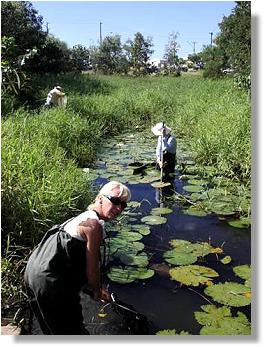 |
| Louisa Creekwatch Team Conducting Macroinvertebrate Monitoring in 2007 |
Establishing
a long term data record that can be compared against reference sites
on a creek or river (reference sites are sites that are assumed to be
similar to the natural condition of Louisa Creek)
- To detect
if any significant changes in water quality are occurring over time
and if the changes are positive or negative for the health of the ecosystem.
- To recognise
the effects of any significant events as soon as possible, eg. heavy
rain, industrial run-off, erosion, accidents (spills).
- To locate
the point of introduction of any pollutants from industrial sites, homes
etc., so management strategies can be implemented to prevent this.
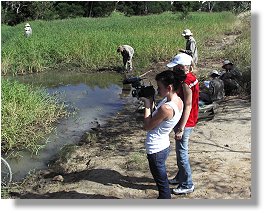 |
Media Involvement With
Macroinverebrate Monitoring |
|
|
Fish and
Macroinvertebrate Monitoring
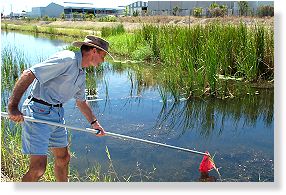 As
a component of the Louisa Creekwatch environmental monitoring activities,
the team monitors in-stream animal life including fish and macroinvertebrates.
One of the most important attributes of the Louisa Creek system, is its
function as a native fish breeding area. The fact that the connection
still remains between the freshwater reaches of the creek and the estuarine
habitat closer to the coast is extremely important for the recruitment
of native fish species. Monthly fish monitoring to collect fish population
data is carried out using dip netting and bait trapping techniques. As
a component of the Louisa Creekwatch environmental monitoring activities,
the team monitors in-stream animal life including fish and macroinvertebrates.
One of the most important attributes of the Louisa Creek system, is its
function as a native fish breeding area. The fact that the connection
still remains between the freshwater reaches of the creek and the estuarine
habitat closer to the coast is extremely important for the recruitment
of native fish species. Monthly fish monitoring to collect fish population
data is carried out using dip netting and bait trapping techniques.
An important
biological characteristic of water is the type and number of macroinvertebrates
(water bugs such as dragonflies, beetles and even yabbies). Different
aquatic animals have different tolerances to water quality and pollution.
The Creekwatch team, with the help of students from the Heatley Special
Education Unit, catch bugs in the creek. By identifying which bugs are
present, and which ones are absent, it is possible to gauge the quality
of the water.
|
|
How You
Can Help the Creek
There are
many very simple ways that we can all help to improve the water quality
not only in Louisa Creek, but all our local streams. The first step to
making a difference is understanding that we all live in a catchment and
that anything that leaves your backyard ends up in your local waterway
and eventually Cleveland Bay. Here are a few tips that will make a difference
to Louisa Creek:
- Put your
garden clippings and kitchen scraps in a covered compost bin; never
hose grass down the drains or dump garden waste on creek banks.
- Always
clean up after your dog; wrap droppings and put them in the bin.
- Sweep
up dirt and place it in the garden rather then hosing it down the drain.
- Wash your
car on the lawn, this allows the grass to filter nutrients from the
soapy water.
- Reduce
the use of fertilisers (start a compost bin), herbicides and pesticides
and only use these in dry conditions.
- Properly
dispose of used oils, paint and other chemicals at your local waste
disposal site.
How to get involved:
Contact Mick Brady, the Creekwatch coordinator on (07) 4721 4077,
mobile: 0428533078, or email: mbrady@cva.org.au
  
|
